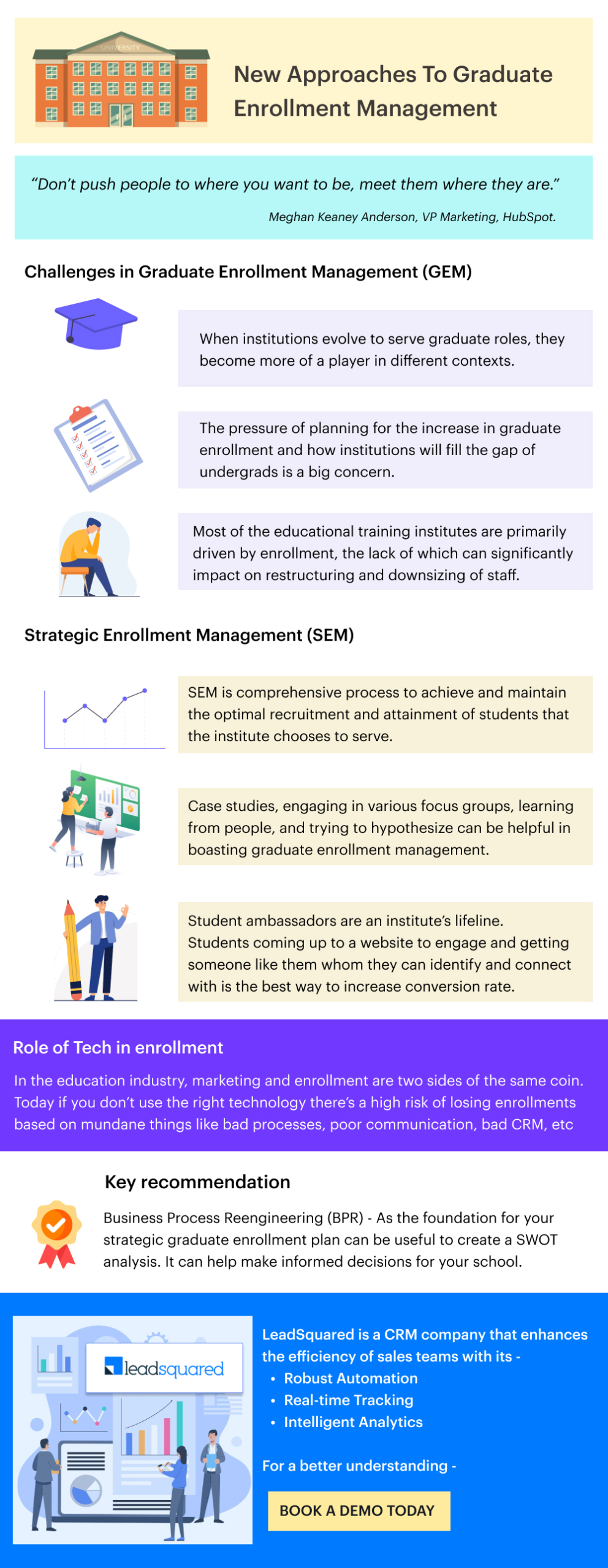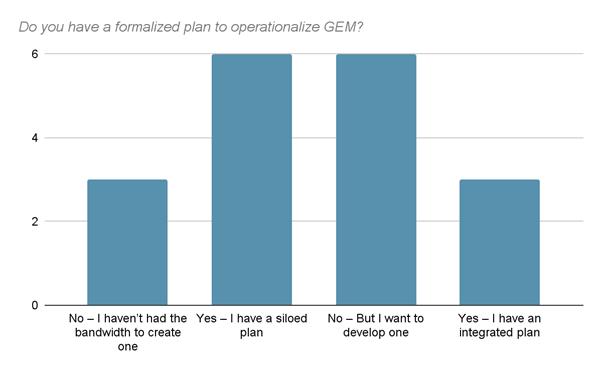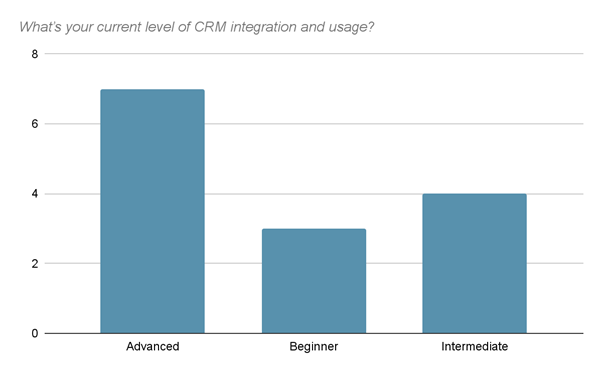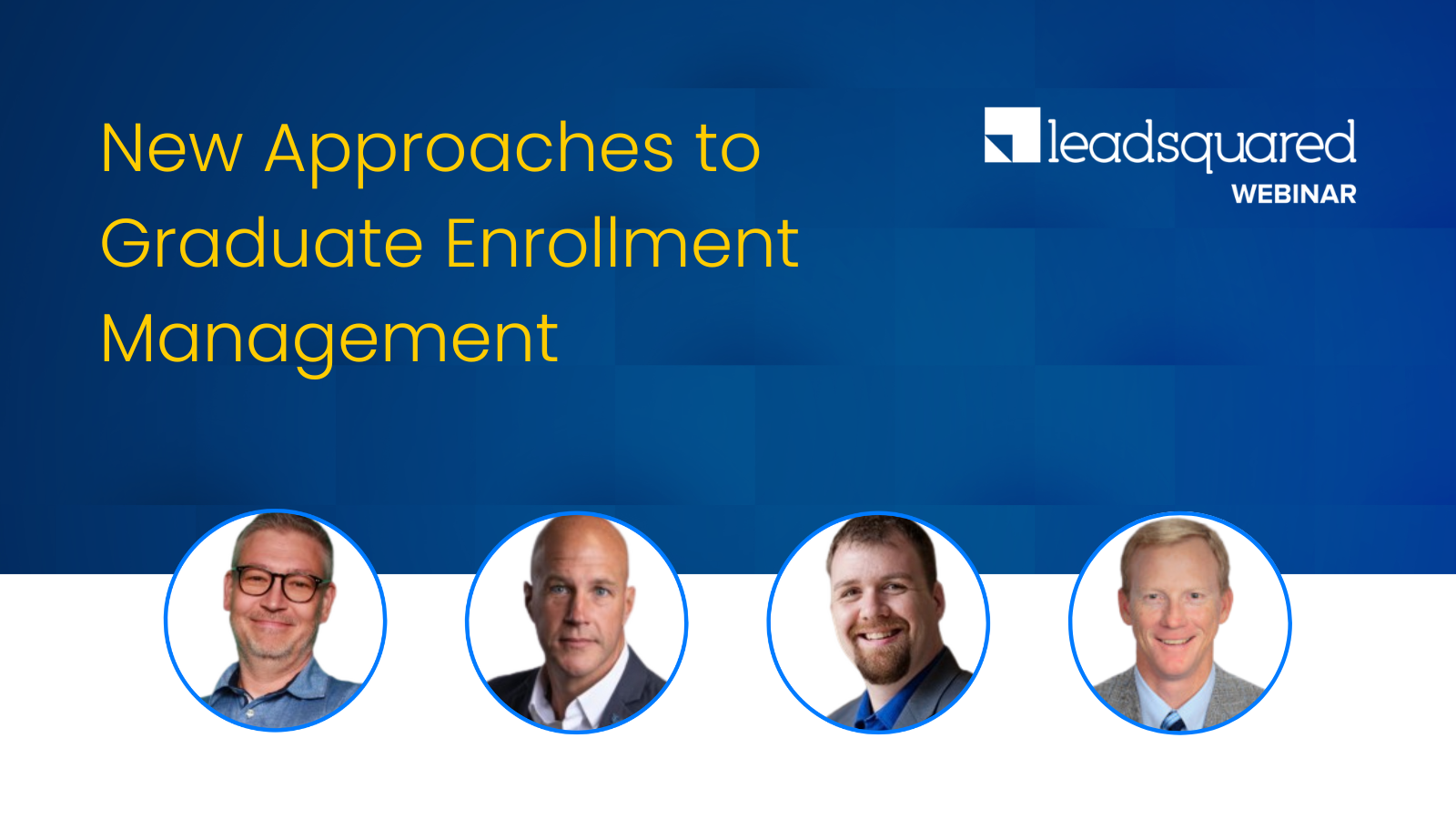There has been an ongoing shift in the higher education landscape and the pandemic has increased uncertainty about the future. Enrollment sits at the forefront.
Our esteemed panel will discuss the evolution of graduate enrollment management and how different approaches to managing the graduate student lifecycle can lead to different results.
Speakers:
- Mickey Baines – Partner, Kennedy & Company
- Joshua LaFave – Director, Graduate Business Programs, Clarkson University
- Christopher Connor – Assistant Dean and Chief Enrollment Officer, University at Buffalo
- Jeff Gibbs – Senior Account Executive, LeadSqaured
Key Takeaways:
- All educational institutes are mainly driven by enrollment, the lack of which has significant negative impacts like restructuring and downsizing of staff.
- It’s essential to look at where the best graduate enrollment management model can be implemented to support institutions that need to enhance graduate enrollment management.
- Students engaging and identifying someone they can connect with is the perfect tactic to increase conversion and applications in enrollments.
- Enrollments can be lost due to bad processes, poor communication, bad CRM, and other things that are within your control.

“Don’t push people to where you want to be, meet them where they are.”— Meghan Keaney Anderson, VP Marketing, HubSpot.
In the education industry, marketing and enrollment are two sides of the same coin. Effective enrollment management is nothing but well-planned strategies and tactics, which was precisely the topic of discussion in today’s webinar.
The session started with a brief round of introduction from all the panelists. They spoke about their experience in the industry and their areas of expertise.
Next, Jeff Gibbs, Senior Account Executive, LeadSquared establishes the webinar’s agenda. The panelists would be talking about
- The current state of Graduate Enrollment Management (GEM)
- GEM: siloed approach vs. integrated interdependence model
- How incorporating tech can help you
Other strategies for enrollment
Challenges in Graduate Enrollment Management (GEM)
He then asks Josh to talk about some of his challenges and observations from on campus.
Joshua takes over to explain how many of his challenges are actually related to resource allocation and strategic planning for the same.
“I always use the term of reactive rubberband,” he said. When enrollment declines, there are significant issues in traditional undergraduate institutions.
The pressure of planning for the increase in graduate enrollment seems reactive, and it is always a big concern how institutions will fill the gap of undergrads.
Joshua broke down how all educational training institutes are primarily driven by enrollment, the lack of which has significant negative impacts like restructuring and downsizing of staff.
His solution to this is an effective discussion around optimizing and efficiencies from a personnel standpoint. According to Josh, it makes more sense to centralize everything because, from the overhead perspective, optimizing is cheaper.
But is it best for retention, persistence, and long-term enrollment growth?
“It’s always that, that balance of making investments,” which in the short term will save money and, in the long run, will be a strategic decision.
“That’s really why a lot of our research work is around strategic graduate enrollment,” Josh says.
Also, talking about the need for innovation, he says that innovating and developing new programs in the current state of shared governance and optimizing scheduling is always very challenging.
While it’s important to have those types of structures in place, the challenge is that the time to actually get to that point continues to get longer and longer, despite the need to be out there faster, gets shorter and shorter.
Christopher then speaks next to put his views forth. He agrees with Joshua’s points and adds to them.
He explains how there is a disconnect, in many cases, between the new program development and actually reframing the existing curriculum that is on campus.
To further explain his challenge, he used an interesting analogy from the Sunagro conference in Toronto, where he presented earlier that week.
“We use the analogy of the Ford Pinto, I can put as much marketing behind a 1975 Ford Pinto to try to sell it, and I can spend millions and millions of dollars, but in the end, what am I getting, I’m going to sell, maybe get a couple of people to join on, but am I ultimately going to be able to increase my interest in this particular product.”
With regards to these challenges, he then talks about wanting to discuss more on the operationalization of Enrollment Management (graduate enrollment management) and how they are putting a lens of being able to be the best they can be with scalability.
Universities are all structured differently. It’s essential to look at where the best graduate enrollment management model and admission strategy can be implemented to support institutions that need to increase or enhance graduate enrollment management.
Mickey then takes his turn to speak next. He says that it takes a while to roll out a program, and they can’t just decide in one day to offer a new graduate-level program and have it launched immediately.
“You can’t just look at a year’s worth of data, and it’s kind of difficult to look at enrollment data right now because we’re coming out of the pandemic, and that changed enrollment data.”
He vividly explains that looking at that type of data, and thinking about how to invest one’s resources as a whole, is something to think about.
Mickey, at this point, noted that from the consulting side, they have several clients that are very focused right now on certificate programs and graduate programs.
GEM: Siloed Approach vs. Integrated Interdependence Model
The conversation then turned towards a decentralized versus a centralized approach to student engagement, how they engaged faculty and staff, and the value of the two models.
Josh rightly pointed out how “there’s really nothing out there for graduate education, it’s nothing that’s defined, there’s no specific conversations, both from an academic research article contexts.”
As institutions evolve as graduate roles, they become more of a player in many different contexts they hadn’t necessarily been in before.
He went on to explain that Strategic Enrollment Management, or SEM is a comprehensive process to achieve and maintain the optimal recruitment and attainment of students that the institute chooses to serve.
One of his approaches included doing a lot of case studies, engaging in various focus groups, learning from people, and trying to hypothesize what graduate enrollment management is.
That’s when they came up with a comprehensive approach; the methods in which they institute and retain support are just a mirror of SEM.
This means that at the graduate level, they have meaningful conversations around relationships and persistence, especially regarding research. Individual departments manage their own programs, and institutions don’t necessarily have a centralized graduate school.
A GMAC Application Trends Survey showed possible growth in STEM-certified programs.
Possible Growth in STEM-certified Programs
| Domestic | ||||
| Program | 2018 | 2019 | 2020 | 2021 |
| STEM certified | 50% | 48% | 76% | 42% |
| International | |||
| 2018 | 2019 | 2020 | 2021 |
| 36% | 43% | 67% | 49% |
Talking about its meaning from a market-driven perspective, Joshua explained how some students don’t have the ability to pay.
“So G-SEM is something that we’re really working towards.”
“We can’t think about the mix of changing of institutions having to really innovate and think differently about who they’re serving, how they’re serving, is the actualization of SEM at the graduate context is what we’re talking about.”
His takeaway from all this is how they’ve had to organically shift and grow over time, but it’s a comprehensive evaluation of the programs and the disciplines related to graduate planning.
After explaining his point, Joshua moves on to talking about graduate offices.
“The idea of a graduate office is to have somebody who can go out in the open and build relationships. Their primary champion could be this program or their student support services.”
According to him, these people who are curating the experiences are also able to be part of building the content necessary to differentiate themselves from the top into the enrollment funnel.
This paves the way for opportunities to share those cross-functional conversations and come up with a strategic plan that includes all of that. Josh likes to refer to this idea of student services.
The different functions are called the Four Os of the metrology of student services. They allow institutes to pull back and forth the student lifecycle to impact without more staff and everything else.
The first ‘O’ would be onboarding. Technology is a massive piece of this, providing the ability to automate and engage people in unmatched ways.
He concludes by saying how it’s just an introduction to how organically they’ve shifted and become more focused and how they operationalize differently.
Christopher then says that although student experience can drive success in many cases, scalability cannot be understated.
Keeping up with the theme of the conversation, Jeff poses an interesting question to the panelists. What are some of the ways in which you can get faculty and staff on board, create accountability, and get them into the process?
To this, Christopher puts forth the idea of having a campus-wide strategic enrollment planning exercise. The campus looks at where there is overlap, examination of recruiting strategies, and students’ success strategies.
“Being able to look at the whole and the sum of the parts being able to equal what your goals are, I think, is extremely important,” says Christopher.
He nicely explains how having a strategic vision of being able to look at the data to drive some of the decision-making and planning from infrastructure and enrollment ways at the graduate level can be very helpful.
Along the lines of the discussion, Mickey raises an excellent point of actually understanding your audience.
“I mean, if you’re international, and you have it at two o’clock in the afternoon, it may be 2 am where they are. I think that’s important,” said Christopher.
Student ambassadors are an institute’s lifeline.
At an earlier stage in the funnel, students coming up to a website to engage and getting someone like them whom they can identify and connect with is the perfect tactic to increase conversion and applications in enrollments.
Taking up a question from the audience—‘the examples of a plan’, Mickey explains that he likes to look at his portfolio.
“I look at what my enrollment is by the number of programs that I have, and I look at a portfolio of how I drive to get to that enrollment and then plan from there. I just kind of reverse-engineer everything.”
That is Mickey’s strategy to drive enrollment.
The Role of Tech in Enrollment

Looking at the poll results, it was clear that identifying fundamental requirements was essential. Recognizing the set of conditions that will move the needle on the objectives of a graduate school for enrollment or engaging students is the need of the hour.
This is where the conversation took a turn toward the need for CRM in education.
“Dream big and iterate small.”
Depending on where one is in the spectrum of using technology, it is essential to identify the requirements and list them all down. Mickey likes to use an academic model because it helps it write down the same to put them on the same page.
He further explained how “technology allows that you can’t do that well without technology today and if you don’t have technology that does it, you are behind, the further behind you get, the more painful it is and the longer it will take for you to catch up and so that’s really important.”
Mickey takes another poll at this point.

Christopher explains that if you have holes in that bucket of water, you’re going to lose enrollments based on mundane things such as bad processes, poor communication, bad CRM, and other things that are within your control.
A couple of points that he recommends are
- enrollment management
- SWOT analysis
“So, I think you have to start with BPR (Business Process Reengineering) as the foundation for your strategic graduate enrollment plan to help create a SWOT analysis and help inform decisions in your school,” he says.
After a rounded discussion on the importance of a good CRM, Jeff concludes the session with a note on LeadSquared.
LeadSquared is a CRM company that enhances the efficiency of sales teams with its robust automation, real-time tracking & intelligent analytics. For a better understanding, book a demo today.
About Our Panelists

Mickey Baines
Partner at Kennedy & Company
As a consultant and former practitioner in higher education, Mickey has 24 years of experience building, implementing and leading enrollment and student success systems and teams. He spent almost a decade leading a successful adult education program at a small, private college in Pennsylvania that produced record results in enrollment, revenue and retention. As a Partner at Kennedy & Company, Mickey oversees the practices growth, as well as the team in their design, implementation and customization of CRM technologies. Collectively the practice serves over 50 institutions annually with various enrollment and technology projects.

Christopher Connor
Assistant Dean & Chief Enrollment Officer at University at Buffalo
Christopher is a renowned leader with demonstrated experience in growing education institutes, including the University of Buffalo where he currently works at. He redesigned business processes and procedures related to recruitment, admissions, and enrollment which resulted in a 74% overall increase in graduate students and revenue. He has enhanced communication and outreach programs which led to a 231% enrollment of their undergraduates.

Joshua LaFave
Director, Graduate Business Programs at Clarkson University
Joshua is a visionary leader who has spent 18 years of higher education experience in Graduate Enrollment Management (GEM) functional areas including but not limited to strategic and enrollment planning, admissions, recruitment, student services, financial aid/scholarships, and alumni relations. He is a recognized speaker on best practices in enrollment management who currently works for Clarkson University.

Jeff Gibbs
Senior Account Executive at LeadSquared
Jeff has 20 years of sales and consulting experience helping institutions achieve their student enrollment and engagement objectives. Through the use of industry leading software and services, including CRM, student applications, student search and marketing communications, he has helped institutions across the US deploy programs aimed at achieving specific enrollment outcomes. With LeadSquared, he is committed to helping institutions realize the elusive goal of student lifecycle engagement management.








